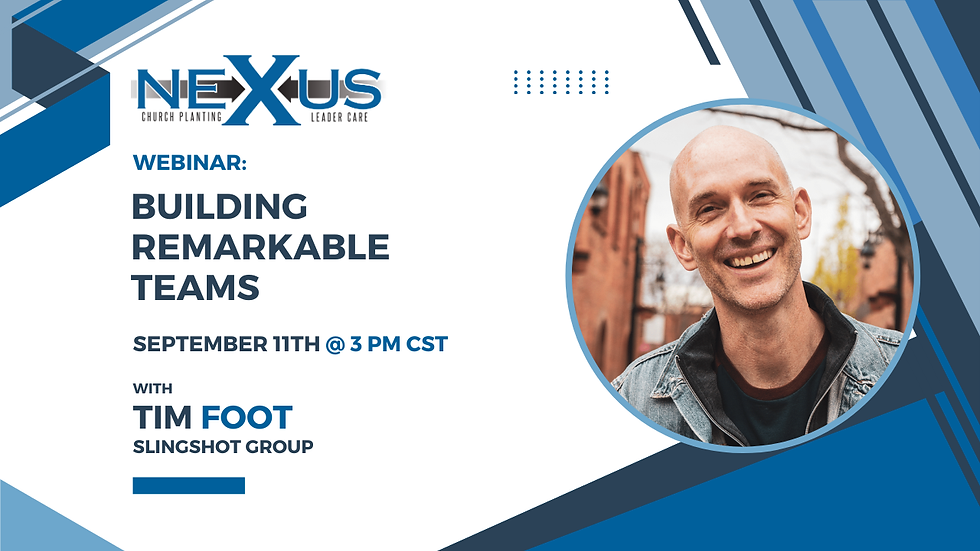Building Remarkable and Healthy Church Teams: Insights from Tim Foot of Slingshot Group
- Andrew Estes

- Sep 22
- 4 min read
Pastors and leaders know this: a remarkable mission deserves a remarkable team.
Recently, I had the privilege of sitting down with Tim Foot, CEO of Slingshot Group, for a Nexus Church Planting webinar. Tim has decades of experience in ministry leadership—serving as a pastor, coach, musician, and now leading an organization that has helped more than 3,000 churches and nonprofits with staffing and coaching.
Our conversation was packed with practical wisdom on team culture, leadership development, succession, and trust. Here are the biggest takeaways for pastors, church planters, and nonprofit leaders who want to build healthier, more effective teams.
What Healthy Church Teams Do Differently
Tim has seen thousands of ministry teams up close. The healthiest ones consistently display seven markers:
Clarity of Identity – They know who they are and what they’re called to do.
Curiosity – They ask great questions and listen deeply before acting.
Systems that Support Mission – Structures and processes keep ministry sustainable.
Relational Equity – Trust is banked in advance so conflict doesn’t bankrupt the team.
Healthy Tension – “Tension is the friction that moves mission forward.” Leaders choose whether it stays healthy or becomes toxic.
Risk-Taking Faith – They step out of the boat when God calls.
Collaboration – Decisions and ownership are shared.
“Every problem in your organization tracks back to a person—either the need for a new one or helping someone unlock greater potential.” – Tim Foot
Why Small Churches Have an Advantage
Most churches in America are under 200 in weekly attendance. While that can feel limiting, Tim reminded us that small teams are often more nimble and more relationally connected.
The challenge? Preference vs. Purpose.
When volunteer leaders hold the mission hostage to personal preferences, growth stalls. But when you keep pointing people back to purpose, even a small team can have a big impact.
The Candidate Crisis and Leadership Development
Like many of us, Tim has seen the candidate pool for ministry roles shrink since the pandemic. Burnout, politics, and lifestyle shifts have left churches struggling to find staff.
But here’s the opportunity: leadership development is discipleship.
Instead of only hiring from outside, churches can:
Develop residencies and apprenticeships.
Elevate high-level volunteers into meaningful roles.
Normalize bivocational leadership.
Treat leadership pipelines as discipleship pathways.
When we disciple people well, we develop leaders who are ready to serve.
Succession Planning: Start Today
One of Slingshot’s specialties is guiding churches through succession. Tim’s advice: start now.
Succession isn’t just about the senior pastor—it’s about every role. Emergencies happen, and healthy church teams and churches prepare leaders at every level.
The healthiest successions are often internal, which shows that a church is continually platforming and investing in people. Leaders need to think like venture capitalists: invest, let people lead, allow them to fail, and coach them forward.
Building Trust on Your Team
Trust is the foundation of Patrick Lencioni’s Five Dysfunctions of a Team, and Tim echoed that truth. But how do you actually build it?
Schedule relational connection. Don’t shortcut relationship-building.
One-on-ones where they drive the agenda. Show you care about their priorities.
Meetings with relational runway. Start with conversation before diving into tasks.
Shared leadership moments. “You don’t work for me—we work together.”
Even for virtual teams, the same principles apply: create intentional space for connection, celebrate wins, and use tools like Slack or Zoom to stay relationally connected.
My Working Genius & Vision Clarity Perspective
What struck me most in this conversation is how much of what Tim described connects directly to the Working Genius model and the Vision Clarity frameworks I use with churches and nonprofits.
Working Genius helps identify the unique ways each person contributes to a team. Curiosity, tension, collaboration—these become visible and coachable instead of mysterious and frustrating.
Vision Clarity (through tools like the Vision Frame) helps teams align around identity, values, strategy, and measures—so culture and mission stay connected even through transitions.
Together, these tools give churches the why, how, and who they need to move from maintenance to multiplication.
A Word of Hope for Pastors
Tim closed our conversation with this vision:
“My hope is for a renaissance of the church—a city on a hill where leadership health, relational equity, holy risk, and new ideas thrive. A place where great leaders want to serve.”
In a time when pastors face exhaustion, declining trust, and shrinking resources, that picture gives me hope.
Take Your Next Step
If you’re a pastor or nonprofit leader who resonates with these insights, here are two ways I can help your team:
Working Genius Team Day – a 2- or 4-hour workshop where your team discovers their wiring and reduces friction.
Vision Clarity Co::Lab – a process to define your mission, values, strategy, and a 12-month action plan.
👉 Schedule a Discovery Call to explore how we can strengthen your team’s culture and clarity.
*AI assisted in writing this blog





Comments